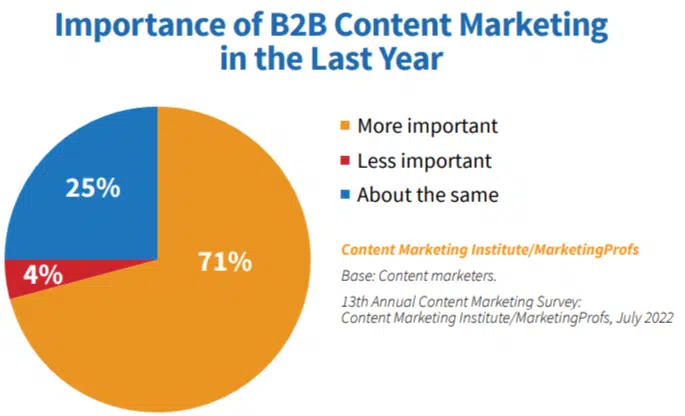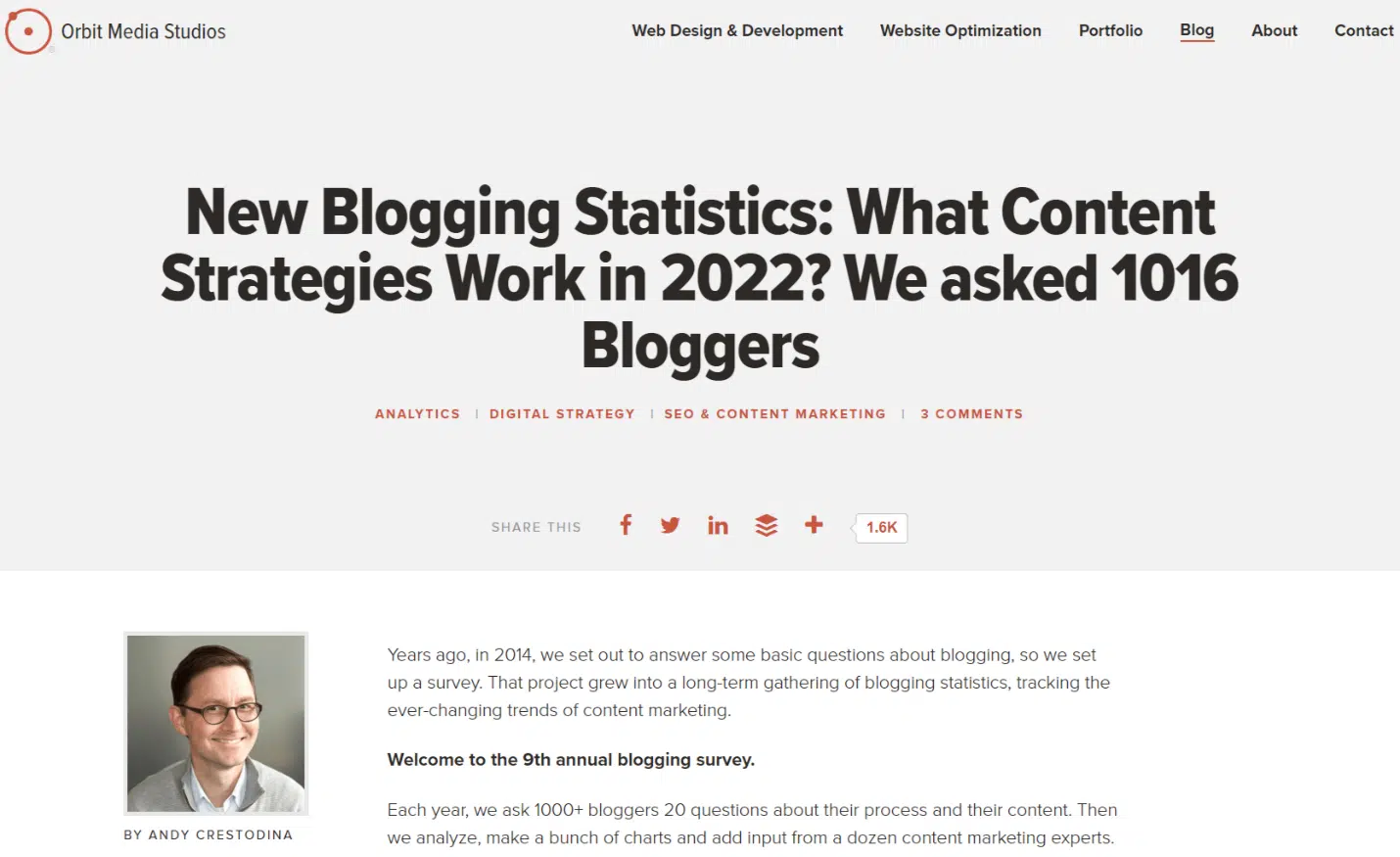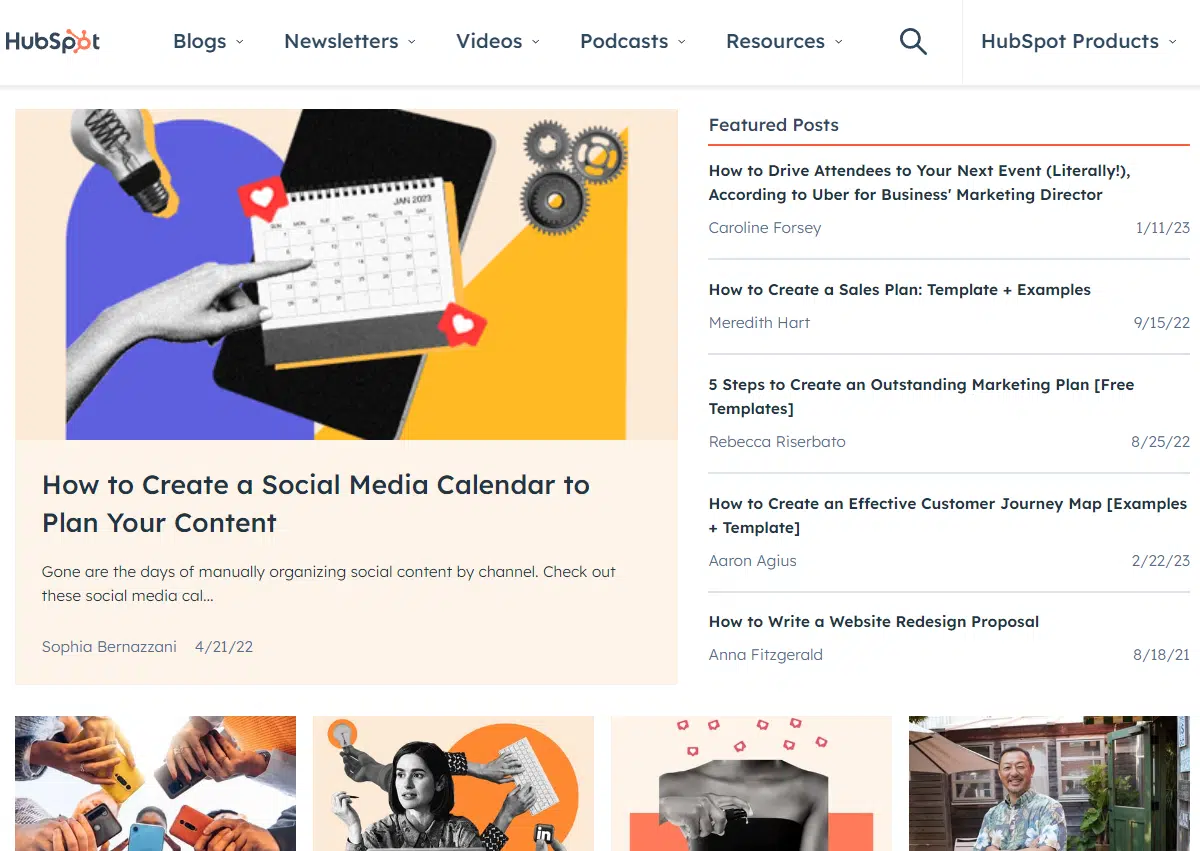Here we are over two decades into the 2000s, but bad B2B content marketing still exists.
Digital content marketing has existed for at least 10 years, but some businesses still make elementary mistakes that wreck their potential for results.
That’s a shame because most content marketers (71%) will tell you that content has only become more important over time.

Most buyers easily ignore ads and actively search out content to help them make purchase decisions (70% of buyers read at least 3-5 pieces of content before talking to a salesperson).
Truly, the businesses that do B2B content marketing right have a giant competitive advantage.
So, what does the right way look like?
Let’s explore both sides of the coin so you can see exactly how to do content marketing the right way.
First: The wrong way to do B2B content marketing
The only way to learn the right way to do content marketing is to understand the wrong way, first. Here are six major no-nos.
1. Not creating a content marketing strategy
This is the biggest sin of content marketing.
If you’re lacking a strategy, you can’t expect consistent results. (A content strategy is a plan that maps out how you’ll create, publish, distribute, and promote content to grow your brand.)
Sure, one of your shots may land. Maybe you’ll create a blog post that gets attention. Maybe your website traffic will spike for a week. Maybe you’ll earn some leads.
But that will come down to mostly luck. And it won’t last because you won’t have a plan in place that keeps your content consistent in quality, frequency, look/feel, and impact.
You need more than luck if you expect your content marketing to help grow your business over time. You need a plan of action. You need to create content from a place of anticipating and fulfilling user needs.
To be effective in the long term, content marketing can’t be reactive or ad hoc. Instead, it needs to be proactive and strategic.
If content marketing is the vehicle, then content strategy is the engine. You can’t race down the road to results without it.
2. Not focusing on your target audience and customers
Many businesses start with content marketing by first thinking about themselves. What could they share? They brainstorm topics based on what’s important to them and what they know.
Huge mistake.
What they don’t realize: Your content should never be focused inwards. It doesn’t matter what you want or what the brand wants.
The vital step is to turn outwards. What does the audience want? What’s important to them? How does this intersect with what you sell?
If you don’t know the answers to these questions, that’s a huge problem you can only rectify with audience research – especially by talking directly to your prospects.
Unfortunately, most businesses make the mistake of not talking to their customers:

You have an entirely different set of concerns and needs versus your audience. You can’t expect to understand their perspective out of hand. That’s guesswork.
Bottom line: Don’t rely on your assumptions about your audience. Don’t guess what’s important to them. And don’t make the mistake of only writing about what matters to you when creating content.
3. Selling versus helping
Imagine this scenario:
You have a question only Google can answer. You consult the search engine. The top result looks promising like it might have the exact information you need. You click.
You can’t read further than the headline because your screen is immediately swallowed by a pop-up asking you to subscribe. “But I haven’t even read anything yet!” you think to yourself.
You click out of the pop-up and begin to scroll, but there’s a banner ad under the first paragraph, and in the next section, the business ungracefully segues into talking about itself and its service.
Where is the information you were promised?
“Yuck,” you think. You click the “X.”
This is a prime example of selling versus helping in content – a big no-no.
Remember, readers aren’t coming to your content to read a sales pitch. They’re looking for information: answers, advice, facts, help, data.
Giving them what they need is one of the main ways you’ll build trust with them, which will lead to bigger gains if you’re consistently doing that over and over.
Content marketing is never about selling. It’s about helping above all.
4. Not promoting your content
If you post a blog and don’t promote it, does it really exist?
No. Because that blog will get zero traffic if no one knows about it. And content with zero traffic is worthless.
You need people reading your content to see any benefits from content marketing. And you’ll have a much better chance of that happening if you promote it.
This doesn’t have to be fancy. Post it on social media. Send out an email telling your subscribers about it.
Never publish something only to let it sit festering on your website. Make sure people know it’s there so they can read it, use it, love it, and ultimately draw closer to your brand because of it.
5. Not optimizing your content for search
You can’t do content marketing without SEO. And you can’t do SEO without content marketing.
They work together symbiotically in a beautiful balance.
That also means trying to do one without the other is asking for failure.
Let’s put it this way:
- Good content is helpful, solves problems, and builds trust with your prospects.
- Good SEO ensures that people searching for your keywords can discover your content in search engines.
- Following the rules of SEO also improves your content’s quality and the user experience on your website.
If you’re going to do B2B content marketing, don’t leave home without SEO and well-optimized content.
6. Expecting results immediately
One of the major fumbles you can make with B2B content marketing is giving up too early.
On average, it can take as long as six months to a year to start seeing results.
This length of time will shift depending on the size of your business, your goals, and your strategy. But in every single case, content marketing does not work overnight or instantly.
It’s a slow burn to success. But once you start seeing results, they should compound over time.
That’s because the great content you published one week ago, one month ago, and one year ago will continue to bring in traffic and leads long after their initial publish date. As long as you’re strategic, your B2B content marketing will be sustainable.
But you have to be patient to wait for that ROI (return on investment) to start appearing.
Get the daily newsletter search marketers rely on.
The right way to do B2B content marketing: 5 examples
B2B content marketing done right looks like these five examples. Study these brands and their content to see the light.
Giving the people what they want: Grammarly

Grammarly knows its audience and creates blog topics that match the questions they’re asking in Google.
That means the brand is not creating posts like “the best editing app for your business” or “why you need an editing app.”
For example, this blog on how to write collaboratively speaks to professionals and students, Grammarly’s target audience. This is a topic they actually struggle with, especially in our world of remote work and Zoom meetings.
Grammarly also creates content to answer common grammar questions people search for such as “when to use over vs. more than” or “when to use who vs. whom.” Grammarly is outwardly focused on what its target audience needs and wants from its content.
Consistency matters: Orbit Media

A regular cadence of content going out on your blog is important for consistency, but so is updating old content so it remains fresh and relevant.
Orbit Media does this well with their blogging survey, which they update with new data and insights every year.
Note that this is a complete update, too. They have resent the survey, collected and compiled the answers, and analyzed them for insights every year since 2014. Then they rewrite the post and update the graphics. Now that’s consistent.
Winning at optimization: Zapier

To see a winning combination of content + SEO, look at Zapier.
Zapier makes automation software, but they’re ranking for terms like “best to-do lists” and “AI image generator.” How? Why?
Zapier integrates with apps like these. That’s how they make relevant content for seemingly random keywords.
However, the point is that it works – the company ranks highly for these keywords and pulls in nearly 1 million in traffic monthly, as this case study shows.

Helping vs. selling: LendingClub
LendingClub offers customers personal and business loans, banking, and investing services. Their blog content is a great example of helping vs. selling.
The emphasis is on education, and when services are mentioned, it’s discreet and relevant to the discussed topic.

A giant of B2B content marketing: HubSpot
HubSpot is a giant in their industry for many reasons, but a major one is its content marketing.
With a vast, robust, consistent blog that produces targeted, high-quality content, plus a strategy that rakes in subscribers and leads with “content upgrades,” it’s no wonder this brand pulls in over six million people to its website annually. (This Sumo report shows just how staggering HubSpot’s success is.)

It’s time to do B2B content marketing the right way
If you long to see the types of results enjoyed by the top B2B brands doing content marketing, know that it’s not out of reach.
What do you need to do, most of all?
Commit.
Content marketing takes a commitment of the highest order to work.
You need to be committed to a strategy, committed to your audience, committed to quality, and committed to being patient as you wait for ROI.
But that commitment is worth it because content marketing is profitable, affordable, sustainable, and what customers want to see from brands.
You just have to do it the right way.
Opinions expressed in this article are those of the guest author and not necessarily Search Engine Land. Staff authors are listed here.
Related stories
New on Search Engine Land

